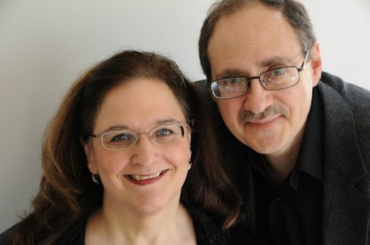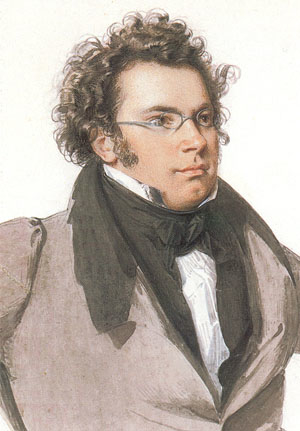The Well-Tempered Ear
Classical music: Why Schubert? Ask pianist-singer Bill Lutes and go to the UW-Madison’s third annual Schubertiade this Saturday night at 8 p.m. | January 27, 2016
By Jacob Stockinger
The third time is the charm.
By then you know a tradition has been born.
For the third year in a row, the University of Wisconsin-Madison is holding a Schubertiade at the end of January, near the birthday of Austrian composer Franz Schubert (1797-1828, below). Can there be a better way to kick off the second semester of concerts and music-making?
The event, which was founded by and now is organized by and performed by the wife-and-husband team of UW-Madison collaborative piano professor Martha Fischer and piano teacher and former music director for Wisconsin Public Radio Bill Lutes, takes place this Saturday night at 8 p.m. in Mills Hall.
Admission is $15 for adults, free for students of all ages. A post-concert reception is included.
ALSO, BE ADVISED THAT THERE IS A UW HOCKEY GAME THAT NIGHT, SO FINDNG PARKING WILL BE MORE CHALLENGING THAN USUAL. ALLOW FOR EXTRA TIME TO GET TO THE CONCERT. THE HALL WILL OPEN AT 7:30 P.M., IF YOU WANT TO COME EARLY AND GET TO YOUR FAVORITE SEATS.
What is it about Schubert that makes him special to the many performers and listeners who will take part?
One answer can be found in a press release from the UW-Madison:
http://www.music.wisc.edu/2015/12/17/third-schubertiade/
More can be found in a story written by Sandy Tabachnick for Isthmus:
http://isthmus.com/music/third-annual-schubertiade-franz-schubert/
But Bill Lutes also agreed to talk about Schubert (below) and the Schubertiade in an email Q&A with The Ear:
This is the third consecutive year of the UW-Madison Schubertiades that you have presented in honor of his birthday on Jan. 31, this year being the 219th. What is it about Schubert that draws audiences and performers to his music?
Probably the most obvious thing we love about Schubert is the endless stream of glorious, memorable melody – melodies that we can only call “Schubertian.” Who can forget a tune like “The Trout” or “Ave Maria” or the famous “Serenade”? These are part of our cultural DNA.
Then there is Schubert’s rich harmonic vocabulary, and his expansiveness and generosity of form. Although he fashioned innumerable miniatures of exquisite perfection – short songs and piano pieces – he also wrote some of the biggest works of the time, including some of the songs we are performing.
They are big in every way, the “heavenly length” that Robert Schumann wrote about and loved, the sense of adventure and the unexpected and the sheer spaciousness of his musical paragraphs — and the long passages of rhythmic obsession that seem to anticipate today’s Minimalist composers.
Above all, his music is unique in the ways it explores the most joyful and the most tragic aspects of our experience, often interwoven, and ambiguously overlapping.
Those of us who are attracted to Schubert feel that he is our friend, our consoler, our guru and our guide to something that shines beyond the travails of our earthly life. He left us such a rich and varied body of music. The amount he composed in his 31 years is absolutely incredible. But also the level of inspiration is so high throughout so much of it.
Your program has a lot of variety. Is there some overarching “theme” that ties the program together?
This year, the pieces we are doing are all inspired by Schubert’s exploration of the sounds and imagery of nature. We’re calling it Schubertian “Naturescapes: Water, Winds and Woodlands.” Schubert came along at a time when the Romantic poets, painters and musicians began to think of nature in a new way.
Like Frank Lloyd Wright, Schubert and his poets spelled Nature with a capital N. The poetry he set to music often evokes the grandeur and sublimity of Nature, and the ways that we humans experience transcendence by observing mountains, forests, lakes and seas, and rushing winds or gentle breezes. All of the lieder that we have selected for this program reflect this almost religious attitude toward Nature (depicted below in the painting “Summer,” with a couple embracing amorously under a tree, by the Romantic German artist Casper David Friedrich.)
What are some of the challenges that Schubert’s music poses to pianists in particular?
Schubert’s piano style is unique, and calls for an ability to sing on the instrument, and to play with an array of orchestral colors.
Playing his songs of course means that you understand something about what it takes to sing them, and you have to completely get into the poetry and the ideas being explored.
He was a very social and sociable composer, and so a lot of playing Schubert involves playing nicely with others. That includes of course playing duets by two pianists at one keyboard.
Schubert was probably the greatest composer for this medium and wrote some of this greatest works for piano duet.
The two pianists must play the same instrument, and sound as one. It is harder than you might think! The issue of playing in such close proximity to your partner invites a level of physical intimacy that can be quite pleasant or quite awkward, depending on the music in question.
The great pianist Artur Schnabel (below) spoke of “music that is better than it can be played.” He included most of Schubert in this category.
The idea for the Schubertiades originated in Schubert’s lifetime — social gatherings devoted to hearing Schubert’s music, but also to having a good time with friends. How do modern performers recreate this informal atmosphere?
Part of it is the variety of the music, and the large number of performers who will be joining us, most of whom will be seated around the piano on stage during the concert (below top). We will also have seating on stage for audience members who want to have a bit of the intimate feeling of those first legendary Schubertiades (below bottom) held in salons in Vienna.
We aim for an atmosphere of spontaneity and informality, as we have in the past two Schubertiades. We are thrilled this year that our concert is underwritten by a generous donor, Ann Boyer, whose gift has allowed us to include opera singer Jamie-Rose Guarrine (below, in a photo by Peter Konerko) as our featured guest artist and alumna.
We both worked a lot with Jamie-Rose when she was a student here and she’s a wonderful singer who will be travelling to us from New England where she is a new voice faculty member at the University of Massachusetts at Amherst.
And of course we are delighted to be making music with so many of our UW-Madison School of Music faculty, other alumni and friends.
Anything else you want to add?
We will be performing all the songs in their original German. However, you’ll find full German texts and translations at the door. We encourage people to come early and read the poetry before the concert begins. It’s a nice way to familiarize yourself with the gist of the poems without having to be glued to your program while the songs are being sung.
Here is the impressive and appealing complete list of works and performers:
Schubertian Naturescapes – Water, Winds and Woodlands
Jamie-Rose Guarrine (JRG), Mimmi Fulmer (MF), Sara Guttenberg (SG), Marie McManama (MM), Daniel O’Dea (DO), David Ronis (DR), Paul Rowe (PF), Benjamin Schultz, (BS), singers
Soh-hyun Park Altino (SP), violin
Sally Chisholm (SC), viola
Parry Karp (PK), cello
Ben Ferris, (BF), double bass
Daniel Grabois (DG), horn
Wesley Warnhoff (WW), clarinet
Bill Lutes (BL) and Martha Fischer (MF), piano
Program
Wanderers Nachtlied (II), D. 768 Wayfarer’s Night Song (MF, BL) Johann Wolfgang von Goethe
Der Fluss D. 693 The River (JRG, BL) Friedrich von Schlegel
Widerspruch, D. 865, Contrariness (DO, DR, BS, PR, MF) Johann Gabriel Seidl
Auf dem Wasser zu Singen, D. 774, To Be Sung on the Water (SG, MF) Friedrich Leopold, Graf zu Stolberg-Stolberg
Fischerweise D. 881, Fisherman’s Ditty, (BS, MF) Franz Xaver von Schlechta
Die Forelle, D. 550, The Trout (MM, BL) Christian Friedrich Schubart
Piano Quintet in A major “Trout,” D. 667 (SP, SC, PK, BF, MF) Movement IV: Theme and Variations (heard in a YouTube video at the bottom)
Suleika I, D. 720 (JRG, BL); Suleika II, D. 717 (JRG,MF) Marianne von Willemer, rev. Goethe
Auf dem Strom, D. 943, On the River (DO, DG, MF) Ludwig Rellstab
INTERMISSION
Frühlingsglaube, D. 686, Faith in Spring (DR, BL) Ludwig Uhland
Im Walde “Waldesnacht,” D. 707, In the Forest “Forest Night” (PR, BL) Friedrich Schlegel
Dass sie hier gewesen, D. 775, That She has Been Here (MF, BL) Friedrich Rückert
Allegro in a minor ”Lebensstürme,” D. 947, Life’s Storms (MF, BL)
Der 23 Psalm, D. 706, (MM, SG, MF, MF, BL) The Bible, trans. Moses Mendelssohn
Der Hirt auf dem Felsen D. 965, The Shepherd on the Rock (JRG, WW, MF) Wilhelm Müller/Karl August Varnhagen von Ense
An die Musik, D. 547 To Music. Franz von Schober. Everyone is invited to sing along. You can find the words in your texts and translations.
Tags: adventure, alumni, Amherst, art song, artist, Arts, Artur Schnabel, Austria, Ave Maria, baritone, bass, Bible, birthday, Boston, breeze, Casper David Friedrich, Cello, Chamber music, choral music, clarinet, Classical music, Deutsch number, DNA, double bass, duet, faculty, forest, Frank Lloyd Wright, Franz Schubert, German, Germany, Goethe, harmony, hockey, Horn, Jacob Stockinger, Jamie-Rose Guarrine, lake, landscape, lider, lieder, Madison, melody, Mezzo-soprano, minimalism, minimalist music, mountain, Music, nature, New England, opera, painter, painting, Piano, piano duo, poem, Poetry, quintet, river, Romantic, Romantic art, Romantic music, Romanticism, salon, Schlegel, Schubert, Schubertiade, Serenade, shepherd, singer, song, soprano, stream, summer, tenor, text, The Trout, tradition, translation, Trout, Trout Quintet, tune, United States, University of Massachusetts, University of Wisconsin-Madison School of Music, University of Wisconsin–Madison, Vienna, Viola, Violin, vocal music, voice, water, Wind, Wisconsin, wisconsin public radio, woodland, Woods, YouTube
5 Comments »
Leave a comment Cancel reply
This site uses Akismet to reduce spam. Learn how your comment data is processed.
- May 2024
- April 2024
- March 2024
- February 2024
- January 2024
- December 2023
- November 2023
- October 2023
- September 2023
- August 2023
- July 2023
- June 2023
- May 2023
- April 2023
- March 2023
- February 2023
- January 2023
- December 2022
- October 2022
- September 2022
- June 2022
- May 2022
- April 2022
- March 2022
- July 2021
- June 2021
- May 2021
- April 2021
- March 2021
- February 2021
- January 2021
- December 2020
- November 2020
- October 2020
- September 2020
- August 2020
- July 2020
- June 2020
- May 2020
- April 2020
- March 2020
- February 2020
- January 2020
- December 2019
- November 2019
- October 2019
- September 2019
- August 2019
- July 2019
- June 2019
- May 2019
- April 2019
- March 2019
- February 2019
- January 2019
- December 2018
- November 2018
- October 2018
- September 2018
- August 2018
- July 2018
- June 2018
- May 2018
- April 2018
- March 2018
- February 2018
- January 2018
- December 2017
- November 2017
- October 2017
- September 2017
- August 2017
- July 2017
- June 2017
- May 2017
- April 2017
- March 2017
- February 2017
- January 2017
- December 2016
- November 2016
- October 2016
- September 2016
- August 2016
- July 2016
- June 2016
- May 2016
- April 2016
- March 2016
- February 2016
- January 2016
- December 2015
- November 2015
- October 2015
- September 2015
- August 2015
- July 2015
- June 2015
- May 2015
- April 2015
- March 2015
- February 2015
- January 2015
- December 2014
- November 2014
- October 2014
- September 2014
- August 2014
- July 2014
- June 2014
- May 2014
- April 2014
- March 2014
- February 2014
- January 2014
- December 2013
- November 2013
- October 2013
- September 2013
- August 2013
- July 2013
- June 2013
- May 2013
- April 2013
- March 2013
- February 2013
- January 2013
- December 2012
- November 2012
- October 2012
- September 2012
- August 2012
- July 2012
- June 2012
- May 2012
- April 2012
- March 2012
- February 2012
- January 2012
- December 2011
- November 2011
- October 2011
- September 2011
- August 2011
- July 2011
- June 2011
- May 2011
- April 2011
- March 2011
- February 2011
- January 2011
- December 2010
- November 2010
- October 2010
- September 2010
- August 2010
- July 2010
- June 2010
- May 2010
- April 2010
- March 2010
- February 2010
- January 2010
- December 2009
- November 2009
- October 2009
- September 2009
- August 2009
Archives
- 2,491,337 hits
Blog Stats
- Here’s music to mark Mother’s Day May 11, 2024
- What made Beethoven sick and deaf? May 9, 2024
- Beethoven’s Ninth turns 200 today May 7, 2024
- Pianist Yuja Wang’s new ‘Vienna Recital’ is another triumph May 4, 2024
- Gramophone names the 50 best classical recordings of 2024 — so far May 2, 2024
Recent Posts
Recent Comments
| Brian Jefferies on Classical music: A major reass… | |
| welltemperedear on What made Beethoven sick and… | |
| rlhess5d5b7e5dff on What made Beethoven sick and… | |
| welltemperedear on Beethoven’s Ninth turns 200… | |
| Robert Graebner on Beethoven’s Ninth turns 200… |
Tags
#BlogPost #BlogPosting #ChamberMusic #FacebookPost #FacebookPosting #MeadWitterSchoolofMusic #TheEar #UniversityofWisconsin-Madison #YouTubevideo Arts audience Bach Baroque Beethoven blog Cello Chamber music choral music Classical music Compact Disc composer Concert concerto conductor Early music Facebook forward Franz Schubert George Frideric Handel Jacob Stockinger Johannes Brahms Johann Sebastian Bach John DeMain like link Ludwig van Beethoven Madison Madison Opera Madison Symphony Orchestra Mead Witter School of Music Mozart Music New Music New York City NPR opera Orchestra Overture Center performer Pianist Piano post posting program share singer Sonata song soprano String quartet Student symphony tag The Ear United States University of Wisconsin-Madison School of Music University of Wisconsin–Madison Viola Violin vocal music Wisconsin Wisconsin Chamber Orchestra wisconsin public radio Wolfgang Amadeus Mozart YouTube








[…] https://welltempered.wordpress.com/2016/01/27/classical-music-why-schubert-just-ask-pianist-singer-b… […]
LikeLike
Pingback by Classical music: The third annual Schubertiade at the University of Wisconsin-Madison School of Music was so popular and so successful, it should serve as a model for other collaborative concerts featuring other composers. Plus, a FREE concert at noon on — February 4, 2016 @ 6:43 am
[…] https://welltempered.wordpress.com/2016/01/27/classical-music-why-schubert-just-ask-pianist-singer-b… […]
LikeLike
Pingback by Classical music: The third annual Schubertiade at the University of Wisconsin-Madison School of Music was so popular and so successful, it should serve as a model for other collaborative concerts featuring other composers. Plus, a FREE concert at noon on — February 4, 2016 @ 12:20 am
[…] https://welltempered.wordpress.com/2016/01/27/classical-music-why-schubert-just-ask-pianist-singer-b… […]
LikeLike
Pingback by Classical music: The third annual Schubertiade at the University of Wisconsin-Madison School of Music was so popular and so successful, it should serve as a model for other collaborative concerts featuring other composers. Plus, a FREE concert at noon on — February 4, 2016 @ 12:10 am
[…] https://welltempered.wordpress.com/2016/01/27/classical-music-why-schubert-just-ask-pianist-singer-b… […]
LikeLike
Pingback by Classical music: The third annual Schubertiade at the University of Wisconsin-Madison School of Music was so popular and so successful, it should serve as a model for other collaborative concerts featuring other composers. Plus, a FREE concert at noon on — February 4, 2016 @ 12:00 am
Love it and love Schubert, whose music is so, so beautiful. Great tradition to uphold at UW School of Music.
As much as I love Schubert, I think this version of “Ave Maria” by a 20th century Russian composer, Vladimir Vavilov, (sometimes attributed to a long dead Italian but only because the Russian composer lived in the Soviet Union and apparently feared to attach his own name to this work, which was first performed only in about 1970) is even better.
Note that this version is completely different than Schubert’s.
Here is the magnificent Latvian opera singer Inessa Galante singing:
LikeLike
Comment by fflambeau — January 27, 2016 @ 8:43 pm